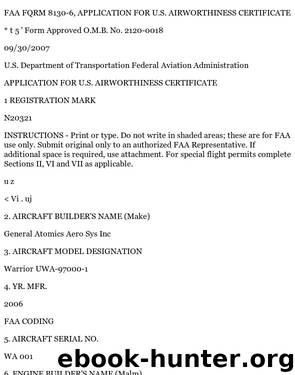n20321.pdf by Federal Aviation Administration

Author:Federal Aviation Administration
Language: eng
Format: epub
Tags: documentcloud;cir
Published: 2013-08-21T16:00:00+00:00
Figure 1: Primary Containment Area (WAC Depiction)
GENERAL ATOMICS AERONAUTICAL SYSTEMS, INC. 6 COMPANY PROPRIETARY
Report: DP06-600-001 Rev: A
Title: Program Letter for ERMP Special Airworthiness Certificate Date: 21 Dec 06
Figure 2: Primary Containment Area
3.2.4 During UAS operation, two-way radio communication will be maintained between the UAS pilot/operator, chase plane and the appropriate FAA Air Traffic controlling facility. If communication cannot be maintained, by the UAS pilot/operator, chase plane or the appropriate FAA Air Traffic controlling facility, the UAS will expeditiously return to its base of operations and the flight will be terminated.
3.2.5 The UAS and the chase plane will have position and strobe lights on at all times. If any of these systems on either aircraft are inoperative the flight will be cancelled.
3.2.6 GA-ASI, and/or its representatives, are responsible at all times for collision avoidance with non-participating aircraft and the safety of persons or property on the surface with respect to the ERMP.
3.2.7 From sunrise to sunset (daytime), UAS operations may be conducted from the surface to 6,000 feet mean sea level (MSL), with the ERMP operator and a ground observer, who is in direct communication with the UAS operator, assisting in see-and-avoid duties for the UAS. The ground observer is responsible for maintaining visual contact with the aircraft at all times. At no time will the aircraft exceed 3.0 NM from the ground observer.
GENERAL ATOMICS AERONAUTICAL SYSTEMS, INC. 7 COMPANY PROPRIETARY
Report: DP06-600-001
Title: Program Letter for ERMP Special Airworthiness Certificate
Rev: A Date: 21 Dec 06
3.2.8 Operations above 13,000 feet MSL and/or outside the area described in paragraph 3.2.3 shall require an Instrument Flight Rules (IFR) flight plan and a chase aircraft in direct communication with Los Angeles Air Route Traffic Control Center (ZLA) or the appropriate controlling Center. ERMP flights may be conducted in Class A airspace (above 18,000 feet) without a chase plane and will require an IFR flight plan and direct communication between the ERMP operator and ZLA. When operating on a flight plan and under positive control, all ATC instructions shall be adhered to.
3.2.9 ERMP UAS operations may be conducted in VFR conditions in the Barstow, Isabella, Owens, Saline, and Panamint Military Operating Areas (MOA) with permission of the controlling agencies. The ERMP shall be accompanied by a chase plane when operating in MOAs
3.2.10 High Desert TRACON may provide traffic advisories to the chase aircraft during the UAS operation. In the event that controller workload prohibits this service, or two-way radio communications cannot be maintained, the ERMP operation shall be canceled.
3.2.11 GA-ASI will coordinate each UAS flight with High Desert TRACON 2 hours prior to the operation for transponder codes. The chase aircraft transponder will be on standby while in formation with the ERMP, but shall be turned on when separated. The ERMP transponder will be turned on and set to the ATC assigned code any time the ERMP is operating. In the case of a transponder failure on either the ERMP or the chase aircraft, the ERMP operation shall be terminated.
3.2.12 GA-ASI will contact Riverside Automated Flight Service
Download
This site does not store any files on its server. We only index and link to content provided by other sites. Please contact the content providers to delete copyright contents if any and email us, we'll remove relevant links or contents immediately.
| Airport | Commercial |
| Helicopters | History |
| Pictorial | Piloting & Flight Instruction |
| Repair & Maintenance |
Small Unmanned Fixed-wing Aircraft Design by Andrew J. Keane Andras Sobester James P. Scanlan & András Sóbester & James P. Scanlan(32744)
Navigation and Map Reading by K Andrew(5111)
Endurance: Shackleton's Incredible Voyage by Alfred Lansing(4677)
And the Band Played On by Randy Shilts(2131)
Wild Ride by Adam Lashinsky(1933)
The Box by Marc Levinson(1933)
Top 10 Prague (EYEWITNESS TOP 10 TRAVEL GUIDES) by DK(1932)
The Race for Hitler's X-Planes: Britain's 1945 Mission to Capture Secret Luftwaffe Technology by John Christopher(1818)
The One Percenter Encyclopedia by Bill Hayes(1787)
Trans-Siberian Railway by Lonely Planet(1705)
Girls Auto Clinic Glove Box Guide by Patrice Banks(1685)
Bligh by Rob Mundle(1653)
Looking for a Ship by John McPhee(1630)
Batavia's Graveyard by Mike Dash(1608)
Good with Words by Patrick Barry(1602)
TWA 800 by Jack Cashill(1594)
Fighting Hitler's Jets: The Extraordinary Story of the American Airmen Who Beat the Luftwaffe and Defeated Nazi Germany by Robert F. Dorr(1591)
Troubleshooting and Repair of Diesel Engines by Paul Dempsey(1557)
Ticket to Ride by Tom Chesshyre(1543)
